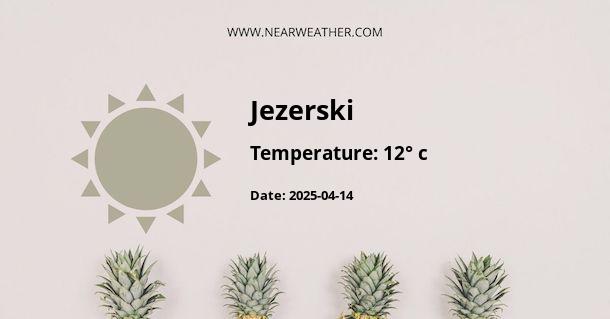Exploring the Climate and Weather of Jezerski, Bosnia and Herzegovina
In the heart of the Balkans lies Jezerski, Bosnia and Herzegovina, a place where the climate and weather patterns are as diverse as the country's history. Understanding its meteorological nuances requires delving into the specifics of its geographic setting, seasonal variations, and the influences that define its weather year-round.
Geographical Influence on Jezerski's Weather
Before we unpack the seasonal weather behavior, it is critical to recognize the geographical factors that sculpt Jezerski's climate. This town in Bosnia and Herzegovina (BA) is nestled within a complex terrain dominated by mountains, rivers, and valleys, which leads to a range of microclimates within a relatively small area.
Topographical Impacts
- Mountain ranges: The Dinaric Alps stretch along the western border of Bosnia and Herzegovina, acting as a climatic barrier that influences Jezerski's weather.
- Altitude: Jezerski's elevation varies significantly across different areas, directly affecting temperature and precipitation patterns.
- Proximity to water bodies: While Jezerski itself may not be adjacent to a major sea, nearby rivers and lakes contribute to local humidity and fog conditions.
Climatic Zones
Jezerski's climate can be classified into two predominant zones:
Continental Climate: Characterized by hot summers and cold winters, this climate zone is more pronounced as one moves away from the Adriatic Sea and into the heartland where Jezerski is situated.
Mediterranean Climate: The influence of the Mediterranean climate, known for its mild, wet winters and hot, dry summers, is felt to a lesser degree in Jezerski, primarily due to the orographic lift provided by the mountains that separate the region from the coast.
Seasonal Weather Characteristics of Jezerski
Jezerski's seasonal variations are well defined, each bringing distinct weather conditions:
Spring (March - May)
- Temperature: A gradual increase from chilly to mild as the threshold of summer approaches; average temperatures range from 5°C to 15°C.
- Precipitation: Moderate rainfall with increasing frequency towards the end of the season.
- Weather Events: Late snowfall can occur in early spring, especially in the surrounding high-altitude areas.
Summer (June - August)
- Temperature: Warm to hot with average temperatures between 20°C to 30°C. Heatwaves can cause peaks above this range.
- Precipitation: Occasional thunderstorms, with July typically being the driest month.
- Sun Exposure: High, with long daylight hours.
Autumn (September - November)
- Temperature: A marked decrease from warm to cool with averages dropping from 20°C to 10°C through the season.
- Precipitation: Initial dryness giving way to increased rainfall as winter approaches.
- Weather Events: First frosts usually appear in late autumn, and snowfall is possible by November.
Winter (December - February)
- Temperature: Often below freezing, especially at night, with averages ranging from -5°C to 5°C.
- Precipitation: Snowfall is common, with the mountainous areas receiving significant snow cover.
- Sun Exposure: Limited, with short daylight hours.
Monthly Climate Data and Trends
For a more granular view, here is a typical climatological overview of Jezerski, showing average high and low temperatures, as well as average precipitation:
| Month | Avg. High Temperature (°C) | Avg. Low Temperature (°C) | Avg. Precipitation (mm) |
|---|---|---|---|
| January | 3 | -3 | 70 |
| February | 6 | -1 | 75 |
| March | 11 | 3 | 80 |
| April | 16 | 7 | 75 |
| May | 21 | 11 | 85 |
| June | 25 | 15 | 90 |
| July | 29 | 17 | 70 |
| August | 29 | 17 | 73 |
| September | 24 | 13 | 77 |
| October | 18 | 9 | 85 |
| November | 12 | 4 | 95 |
| December | 5 | 0 | 82 |
Note: The above is an approximate representation and actual values can vary due to the local microclimate and inter-annual variations.
Climatological Extremes and Weather Anomalies
Like any geographical location, Jezerski is subject to occasional climatological extremes and anomalies which can include:
- Unexpected heatwaves or cold snaps outside of the usual seasonal ranges.
- Higher than average snowfall in winter months, impacting transportation and daily life.
- Heavy rainfall leading to flooding, particularly in areas close to rivers and low-lying valleys.
- Drought conditions affecting agriculture and water supply during drier years.
Mitigating Weather-Related Risks in Jezerski
Understanding Jezerski's weather is not just about comfort, but also about preparedness. With a climate that can swing from balmy Mediterranean to harsh Continental, residents and visitors alike must be aware of the potential risks. The local government and communities often address these issues through:
- Infrastructure: Building resilience into structures to withstand heavy snowfall and potential flooding.
- Resource Management: Ensuring adequate water supply and efficient usage during times of drought or excessive heat.
- Agricultural Practices: Selecting crops and farming techniques suitable for the local climate, and adaptable to changing conditions.
- Emergency Services: Maintaining readiness for rapid response during extreme weather events.
In conclusion, Jezerski's climate and weather promise a rich tapestry of seasons where each brings its own beauty and challenges. For the people living in and visiting Jezerski, understanding these patterns means the difference between thriving in harmony with nature or being caught off guard by its next move.
A - Jezerski's Latitude is 44.980831 & Longitude is 16.084169.
A - Weather in Jezerski is 12° today.
A - Climate Conditions in Jezerski shows overcast clouds today.
A - Humidity in Jezerski is 81% today.
A - Wind speed in Jezerski is 4.79 km/h, flowing at 136° wind direction. today.
